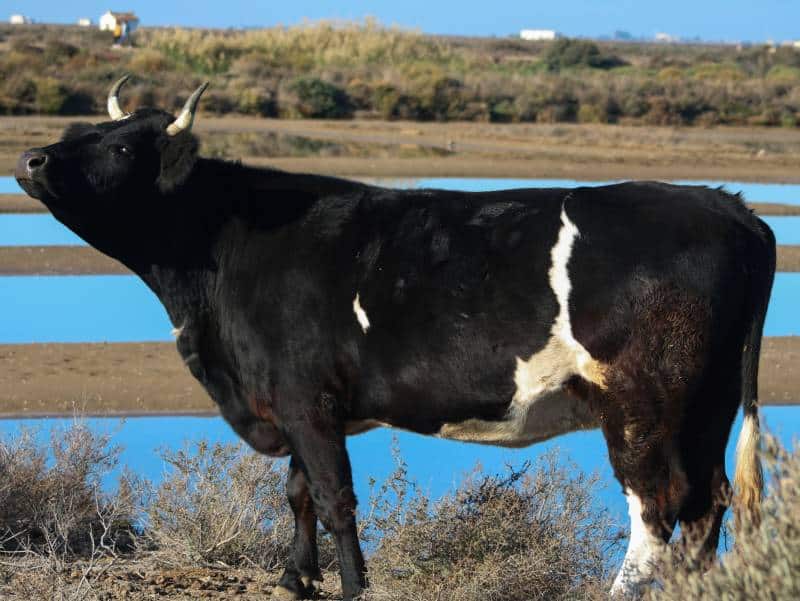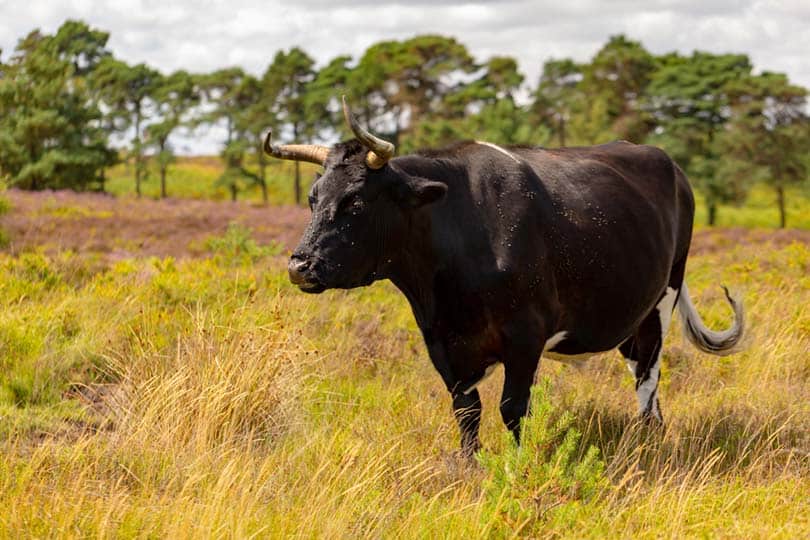This smaller breed of cattle from the Shetland Isles in Scotland is commonly described as being hardy. Originally brought to the islands by Neolithic settlers as early as 3600 BC, this ancient breed of cattle is known for being easy to calve and outwinter.
Shetland cattle are commonly used for their meat, as it is coveted by niche markets and sells for a good price. Let’s look at some quick facts about this versatile breed.

Quick Facts about Shetland Cattle
| Breed Name: | Shetland |
| Place of Origin: | Shetland Isles, Scotland |
| Uses: | Meat, Milk, Conservation Grazing |
| Bull (Male) Size: | 52” |
| Cow (Female) Size: | 48” |
| Color: | Black and White |
| Lifespan: | Late teens and older |
| Climate Tolerance: | Good to Great |
| Care Level: | Easy |
| Production: | Meat, Milk |
Shetland Cattle Origins
As mentioned, Shetland cattle are an ancient breed of livestock. Around 3000 BC their ancestors arrived in the islands for which they are named. This breed was called the Auroch and was originally much larger.
There is much research that needs to be done, however, researchers have speculated that around 1000 AD, the Norsemen who arrived either used the cattle that were present or brought their own. It is unclear however there were cattle in Norway at the time which do resemble the Shetland breed, so it is possible that they came from Norway and were bred with the lineage that was already present on the islands.

Shetland Cattle Characteristics
This cattle breed is known as being exceptionally useful, fertile, and easy to calve. They are a tough, enduring breed despite their stature. This breed is known for being aesthetically appealing and not only turn out great meat, but they are also excellent grazers. They require few concentrates if any at all and are self-sufficient. While hardy, they are not known as being hotheads. They have a calm demeanor and are easy to handle.
This breed of cattle is excellent at foraging and does extremely well in poor grazing situations. Shetland calves also grow very quickly, despite their smaller stature, so the quality and quantity of their output are quite good for meat.
Uses
Shetland cattle are known to be high-grade beef, which sells for a premium. They are also great dairy cows, and as time goes on, people are starting to get wise to the fact that the Shetland species of cattle is a fantastic conservation grazer.
Appearance & Varieties
Traditionally, Shetland cattle are known for their black and white markings and, appropriately, small, Viking-shaped horns. Another characteristic is their size—they only grow to about 4 feet tall, which is small for a cow.
While they have predominantly been known to be white and black or gray, more color varieties have begun to appear lately including red and brown. Their summer coats are smooth, and their winter coats woolier, as are those of the calves when they are born.

Population/Distribution/Habitat
As their name denotes, this species comes from the Shetlands islands of Scotland. Having been around for so long, they can now be found throughout North and South America, other parts of Europe, as well as Australia. This little cow from Scotland has made its way around the world in its time!
Are Shetland Cattle Good for Small-Scale Farming?
This species of cattle is ideal for small-scale farming. They thrive in poor grazing conditions, and their meat is highly valued as superior quality. Their smaller stature also allows for easy handling and more animals in the herd. This makes Shetland cattle a great choice of livestock for small-scale farming operations.

Conclusion
All in all, Shetland cattle make a fantastic breed of herd animal to raise. They are versatile and, as far as cattle go, quite easy to care for and handle. It’s a small wonder that this species is such a popular breed when you consider their versatility as well as their usefulness in greener farming practices. We highly recommend them to farmers who are looking for a hardy and useful breed of livestock to farm and may not have as much experience handling bigger breeds of cattle, or farmers looking to sell a premium product to a niche market and make a decent return.
Featured Image Credit: Jordon Sharp, Shutterstock
